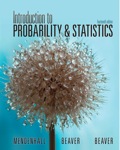
(a)
To find: whether the given data is an evidence for the difference in mean times to absorption for the two drugs.
(a)
Answer to Problem 10.83SE
There is sufficient evidence to indicate a difference in mean times to absorption for the two drugs.
Explanation of Solution
Given:
| Drug A | Drug B |
Calculation:
The null and alternative hypotheses are,
The alternative hypothesis
For Drug A:
For Drug B:
The pooled estimator for
The test static is,
Comparing the observed value of the test statistic
Therefore, you can reject the null hypothesis.
Therefore, there is sufficient evidence to indicate a difference in mean times to absorption for the two drugs.
Conclusion: Therefore, there is sufficient evidence to indicate a difference in mean times to absorption for the two drugs.
(b)
To find: the approximate p-value and explain whether the result confirms the conclusion.
(b)
Answer to Problem 10.83SE
There is sufficient evidence to indicate a difference in mean times to absorption for the two drugs. Yes. It confirms our conclusion in part a.
Explanation of Solution
Given:
| Drug A | Drug B |
Calculation:
Since the value,
Since, the p-value is less than
Thus, there is sufficient evidence to indicate a difference in mean times to absorption for the two drugs.
Yes. It confirms our conclusion in part a.
Conclusion: Thus, there is sufficient evidence to indicate a difference in mean times to absorption for the two drugs. Yes. It confirms our conclusion in part a.
(c)
To find:
(c)
Answer to Problem 10.83SE
A
Yes. It confirms our conclusion in part a.
Explanation of Solution
Given:
| Drug A | Drug B |
Calculation:
If you choose a
A
Since, the interval do not contain zero, you can reject the null hypothesis.
Thus, there is sufficient evidence to indicate a difference in mean times to absorption for the two drugs.
Note that the confidence interval does not contain 0, which indicates that the population means are difference and thus this confirms our conclusion in part a.
Conclusion: A
Want to see more full solutions like this?
Chapter 10 Solutions
EBK INTRODUCTION TO PROBABILITY AND STA
 Glencoe Algebra 1, Student Edition, 9780079039897...AlgebraISBN:9780079039897Author:CarterPublisher:McGraw Hill
Glencoe Algebra 1, Student Edition, 9780079039897...AlgebraISBN:9780079039897Author:CarterPublisher:McGraw Hill
